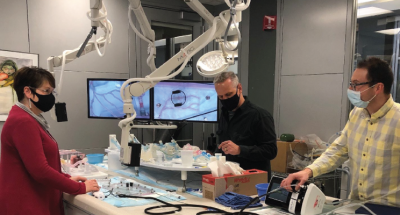Global corporations: the tortoise or the hare? Why start-ups aren't the only agile innovators

I’m often asked where the best innovation comes from, and it always gets me thinking about what it really means to “innovate.” And, how the innovation engine of a company remains agile and flexible, with enough capacity and creativity to outmaneuver its competitors as it grows.
Experience tells me that innovation is unleashed when teams apply an agile attitude to their ways of working. I’ve seen the most innovative solutions come from teams that embrace change, and who are willing to accept and learn from failure quickly.
It’s important to remember that consumers, be it a patient or surgeon, are choosy. What we thought they desired at the start of the development cycle could have transformed by the time we’re happy with a prototype, which is why adaptability and agility are fundamental to innovation.
Going slow to go fast
In my organization, we go slow to go fast. Working smarter, and harder, is how you really make an impact in a large global company. One of our China teams recently demonstrated this when they identified the need for a remote data sharing solution and worked quickly to build a prototype. Once it was ready, the team slowed things down to gather extensive marketing and customer feedback. They went back to implement the feedback swiftly and turn the prototype into a remote training solution that helps guide surgical procedures. This is the type of pace that allows us to pivot and yet stay ahead of the game.
In the middle of my career, I took up some roles in start-ups—attracted to the endless possibilities of forging my own path in a smaller company. I enjoyed the chance to try on different hats, learned a lot about speed and took the occasional leap of faith. The lab of a start-up is filled with urgency, which is incredibly exciting, and there is so much to learn from the tenacity of smaller companies. However, I’m a bit of an outlier to others who made the same jump in that I chose to come back to the multinational corporation way of innovating.
I’ve learned that the culture of a company, something built up over decades, is what forms the bedrock of transformative thinking. Innovation is in the eye of the customer, and a long-term investment in innovation culture is what I think sets an organization up for success. It’s why my teams thrive in the Boston Scientific R&D labs, where we focus on many projects that engage the multitude of skills in our teams while keeping the customer front and center.
Work hard and think big
Testing assumptions, and being prepared to flip everything on its head to get under the skin of the end user, is deeply embedded into the Boston Scientific culture. This freedom to think big and bold drives the smaller, unconscious decisions that allow us to deliver groundbreaking technology that holds true to advancing science for life.
The value of adding a two week-long trip to visit physicians in different markets, watching minimally invasive surgeries take place in real time to understand the nuances of a product’s development for said market for example, should not be underestimated in the innovation process. If physicians in China have been trained to use their left hand for a procedure when surgeons in another market use their right, our product must accommodate both. The beauty of working in R&D for a global leader is the knowledge, resources, and deep talent pool at your disposal to just make things work. I remember an instance, where my team, by leveraging clinical data, being smart with algorithms, regulatory innovations, and existing resources, delivered an atrial device to patients around the world. This not only could be used as an implantable defibrillator, but worked to tackle atrial arrhythmia too. We need to understand that every patient is unique with different needs and our products should be diverse and yet as innovative as possible.
You don’t always need to think outside the box
My experience working at a start-up allowed me to return to Boston Scientific with a panoramic understanding of the entire R&D spectrum. It takes more than telling your team you need ideas and asking people to think outside the box – is there a box there to begin with? What are you doing as a leader that encourages abstract thinking without saying it?
For me, to innovate means to add value and novelty to the lives of customers, while seeking continual improvement. There should always be room to learn, wherever you are in your career. In this industry, it pays to be malleable and unafraid of change—because true innovation is in the eye of the customer, who may not always know what they want or what they need until they see it.
Learn more about the ways we create a culture of innovation at Boston Scientific.